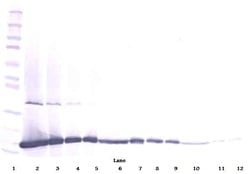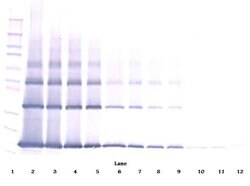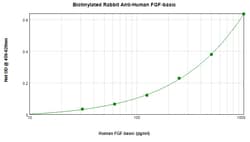Learn More
Invitrogen™ FGF2 Polyclonal Antibody, Biotin, PeproTech®, Invitrogen™
Rabbit Polyclonal Antibody
Supplier: Invitrogen™ 500P18BT500UG

Description
AA Sequence of recombinant protein: AAGSITTLPA LPEDGGSGAF PPGHFKDPKR LYCKNGGFFL RIHPDGRVDG VREKSDPHIK LQLQAEERGV VSIKGVCANR YLAMKEDGRL LASKCVTDEC FFFERLESNN YNTYRSRKYT SWYVALKRTG QYKLGSKTGP GQKAILFLPM SAKS. Preparation: Produced from sera of rabbits immunized with highly pure Recombinant Human FGF-basic. Anti-Human FGF-basic-specific antibody was purified by affinity chromatography and then biotinylated. Sandwich ELISA: To detect hFGF-basic by sandwich ELISA (using 100 μL/well antibody solution) a concentration of 0.25-1.0 μg/mL of this antibody is required. This biotinylated polyclonal antibody, in conjunction with PeproTech Polyclonal Anti-Human FGF-basic (500-P18) as a capture antibody, allows the detection of at least 0.2-0.4 ng/well of Recombinant hFGF-basic. Western Blot: To detect Human FGF-basic by Western Blot analysis this antibody can be used at a concentration of 0.1-0.2 μg/mL. Used in conjunction with compatible secondary reagents the detection limit for Recombinant Human FGF-basic is 1.5-3.0 ng/lane, under either reducing or non-reducing conditions. 500-P18BT-1MG will be provided as 2 x 500 μg
FGF2 (FGFb, fibroblast growth factor basic) belongs to the fibroblast growth factor (FGF) family, and interacts with high-affinity transmembrane receptors to influence cell proliferation and tissue neovascularization. FGF2 exists as five isoforms with distinct intracellular localizations and functions. The 18 kDa isoform is predominantly cytosolic and acts through cell surface receptors, whereas the 22, 22.5, 24 and 34 kDa isoforms are nuclear and may signal independent of transmembrane receptor pathways. In humans, the gene is located on the q arm of chromosome 4. FGF2 has been implicated in diverse biological processes, such as limb and nervous system development, wound healing, and tumor growth. The mRNA for FGF2 contains multiple polyadenylation sites, and is alternatively translated from non-AUG and AUG initiation codons, resulting in five different isoforms with distinct properties. The CUG-initiated isoforms are localized in the nucleus and are responsible for the intracrine effect, whereas, the AUG-initiated form is mostly cytosolic and is responsible for the paracrine and autocrine effects of this FGF. Diseases associated with FGF2 dysfunction include Kaposi Sarcoma and corneal neovascularization.
Specifications
| FGF2 | |
| Polyclonal | |
| Biotin | |
| FGF2 | |
| Basic fibroblast growth factor; basic fibroblast growth factor bFGF; bFGF; FGF; fgf basic; Fgf2; Fgf-2; Fgfb; FGF-b; Fibroblast growth factor; fibroblast growth factor 2; fibroblast growth factor 2 (basic); Fibroblast growth factor basic; HBGF-2; Heparin-binding growth factor 2; H-FGF-b-147; H-FGF-b-154; M-FGF-b; Prostatic growth factor; prostatropin | |
| Rabbit | |
| Antigen Affinity Chromatography | |
| RUO | |
| 2247 | |
| -20°C | |
| Lyophilized |
| ELISA, Western Blot | |
| 0.1-1.0 mg/mL | |
| PBS with no preservative | |
| P09038 | |
| FGF2 | |
| E.coli-derived Recombinant Human FGF-basic (154 a.a.). | |
| 500 μg | |
| Primary | |
| Human | |
| Antibody | |
| IgG |
The Fisher Scientific Encompass Program offers items which are not part of our distribution portfolio. These products typically do not have pictures or detailed descriptions. However, we are committed to improving your shopping experience. Please use the form below to provide feedback related to the content on this product.


